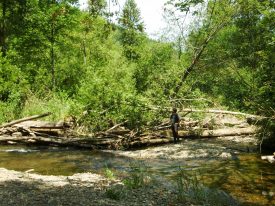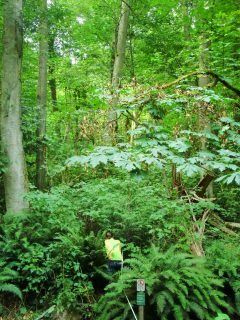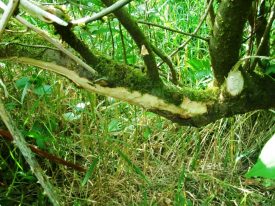by Michelle Bahnick

Chris Gower assessing large woody debris at Issaquah Creek.
I am currently pursuing a Master of Science degree in the Biology Department at Western Washington University. My project focuses on evaluating a protocol called the Stream Function Assessment Methodology (SFAM), which assesses the processes that create and maintain stream ecosystems. SFAM is currently under development by the Oregon Department of State Lands, the U.S. Environmental Protection Agency (EPA), and the U.S. Army Corps of Engineers in collaboration with Willamette Partnership. SFAM aims to provide a comprehensive stream reach assessment by combining stream attributes across a variety of spatial scales to create ratings for biological, hydrological, water quality, and geomorphological stream functions (Willamette Partnership 2013). SFAM calculates scores for stream reaches by integrating data from field assessments and from office work. The methodology has been developed specifically for stream systems in Oregon and has not yet been evaluated for application outside of Oregon.

Michelle Bahnick performing a vegetation survey (line-intercept method) at Piper’s Creek.
I collaborated with King County and the Willamette Partnership to assess the ability of SFAM to rate the extent of degradation of wadeable streams in western Washington. During the summer of 2015, a research assistant and I conducted SFAM on 36 publicly available stream reaches in Water Resource Inventory Area (WRIA) 8. I am comparing the resulting data to recent Status and Trends Monitoring data collected by King County (2009-2013) at the same sites using a modified EPA Environmental Monitoring and Assessment Program protocol (King County 2015). I am also comparing SFAM data to the Washington State Department of Ecology’s Puget Sound Watershed Characterization Tool, which uses spatial analysis to determine the relative conservation value of sub-basins in Puget Sound watersheds (Stanley et al. 2011). I am primarily using correlations to compare appropriately scaled and commensurate variables from the different assessment protocols.

Evidence of beaver presence at Bear Creek.
The challenge with evaluating a protocol in development is that it is still being developed. I received an updated SFAM tool (which calculates multimetric scores for each stream site) in February 2016 — about five months after I thought I had finished my fieldwork! The revisions improved the model’s utility, but I found that I could not provide data for all of the revised metrics from measurements done in the summer of 2015. I had three choices: use the old SFAM tool, use the new SFAM tool without some key data, or use the new SFAM tool and go get the data I needed. My preferred option was to collect all available data for the most recent SFAM tool, which meant revisiting 11 sites. Fortunately, the Dave Lamb Memorial Scholarship provided sufficient funding for me to revisit all the necessary stream reaches during the summer of 2016 (so much for the money I had preserved from last summer’s budget, hoping to replace my well-loved waders). After resurveying the sites, I was able to finalize my dataset in June 2016, and am now finishing my data analysis.
Overall, SFAM has shown little correlation with the Washington methodologies. I am currently trying to discern why this might be. A couple hypotheses are that the Status and Trends data and Puget Sound Characterization Tool data are not comparable to SFAM, missing data (from sources available in Oregon but unavailable in Washington State) are substantially affecting SFAM scores, or the SFAM calculator may need more refinement for streams in Washington. It must be noted that development of the SFAM tool is ongoing, with results and feedback from field-testing and third party review being used to ensure that the accuracy and repeatability of SFAM are high. My goal in finishing my thesis is to better understand my unexpected results to help with future assessments of riparian function in the Pacific Northwest. Overall, I am greatly impressed by the ambitious effort to address the current gap in stream assessment methodologies.
References
- King County. 2015. Monitoring for adaptive management: Status and trends of aquatic and riparian habitats in the Lake Washington/Cedar/Sammamish Watershed (WRIA 8). King County Water and Land Resources Division, Seattle, WA.
- Stanley, S., S. Grigsby, D. Booth, D. Hartley, R. Horner, T. Hruby, J. Thomas, P. Bissonnette, R. Fuerstenberg, J. Lee, P. Olson, and G. Wilhere. 2011. Puget Sound Watershed Characterization Tool Volume 1: The Water Resource Assessments (water flow and water quality). Washington State Department of Ecology, Olympia, WA.
- Willamette Partnership. 2013. OR Stream Function Assessment Methodology User Guide, beta version. Protocol.











